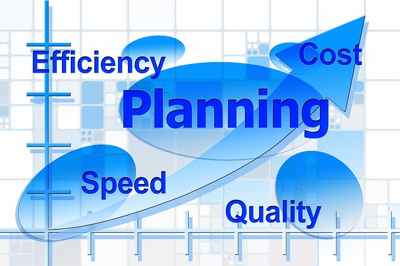This is part three in a five-part series on starting a contractor business. For part four, please click here. You can read part one and part two as well if you missed one.
As a contracting company, your customers are the lifeblood of your business. Happy customers refer their friends and family; unhappy customers leave negative reviews and discourage others from using your services. It’s been said that “a happy customer tells a friend; an unhappy customer tells 10.” In the digital age, amplify that figure exponentially for a clear picture of just how far either positive or negative sentiments about your business can spread.
We’ve put together this comprehensive guide for new contracting companies to outline all the information you need to know about working with your clients, customer satisfaction, and maintaining positive client-contractor relationships so that your customers will happily refer you to their friends and family. We’ve covered everything from how to handle inquiries to estimating projects, setting customer expectations, and other business processes that help you under-promise and over-deliver.

What You’ll Find in This Guide:
Handling Inquiries
Communication with leads and clients is one of the most important business functions for contacting companies. From prompt follow up on initial inquiries, to ongoing communication throughout projects, surveys after projects are complete to gain insights into areas in which you can improve, and ongoing follow up every few months with old leads and prior customers, the following resources offer information on how to get communication right.

Make it easy for potential customers to reach you. That means offering multiple contact methods, such as phone, email, and a contact form on your website, and having systems in place for timely follow up with all contacts.
Build and maintain a database of all your customer inquiries, important contact information, and follow-up needs to ensure that you follow up adequately with potential leads. This resource, which includes insights gleaned from a series of Twitter chats, points out that keeping notes about individual preferences and personalities, along with the key players at each prospect, subcontracting company, vendor, or other entity – including their contact information – will help keep you on track with managing your relationships.
You might also consider using construction lead-generation sites to allow potential clients to both discover and contact you for an estimate. While some companies have more success with third-party lead-generation services than others, many new construction companies find these services a viable way to generate business.
Effective lead management and measurement are important in the early stages of building your business. You should establish a consistent process for following up with leads, as well as measure the success you have in converting leads from the different lead sources that you use. Over time, this data allows you to refine your marketing efforts and allocate most of your budget to the most fruitful sources.
Communication isn’t only important after the initial inquiry, but on an ongoing basis. This article suggests following up with prospects and customers every six months or so, or using tactics such as an email newsletter or direct mail postcards to stay top-of-mind.
Estimating Projects
Aside from communication, estimating projects is a task that you’ll be completing regularly. The following articles and resources offer insights on how to prepare estimates, things to avoid, and other tips for ensuring that your estimating process helps you to convert leads to paying customers.

Understand the specifications of every project and the conditions pertaining to it when preparing pricing estimates. Then, prepare a schedule of risks, the likeliness that each risk will occur, and the risk’s potential impact, allowing you to add appropriate contingencies. This article explains the process of evaluating project risks and adding contingencies effectively while minimizing costs for customers.
There are various methods for estimating projects. Some construction companies hire estimators for this task, while also having sales professionals to manage the sales process. In other companies, the same employee is responsible for both sales and estimates – which, as this article points out, usually means less overhead costs. Regardless of who handles estimates, it’s important to have a specific process and a solid set of plans for estimating projects accurately.
As a new contracting company, you want to avoid making mistakes when estimating projects, as errors can potentially cost your company thousands of dollars (or even more). This article describes two common mistakes made by contracting companies, including omitting essential items from the estimate and being too optimistic about productivity. Additionally, this article offers tips for estimating projects accurately.
The two primary types of construction estimates include fixed price estimates and time and materials estimates. This article, while intended to help homeowners and business owners understand the pros and cons of each type of contract, is a valuable read for new contracting companies to help you determine the estimating method that’s best for you.
Software applications designed specifically for construction companies often include estimating tools. If you’re considering utilizing a software program to manage the various back-office tasks associated with running your business, compare the features, benefits, and costs of several applications before making a decision. A software application with built-in project estimating features can be helpful in maintaining consistency in your pricing approach as well as the format of your company’s estimates.
Use labor man-hours in your estimate. This is one of nine secrets to accurate estimates outlined in this resource from Tempest Company.
Don’t underestimate labor costs. While including an estimate of labor costs is critical for estimating projects accurately, many new contracting companies underestimate this aspect of the total project cost. An ample labor cost estimate ensures that should your project take longer than originally thought to complete, you won’t be stuck footing added labor costs out of pocket.
Even with the best estimating methods and tools, cost overruns are a fact of life in the construction industry. This article discusses estimating errors and cost overruns and offers tips for coping with these issues when they arise.
Project Markups
Most contractors use markups to increase the final sales price on their estimates. While customers sometimes perceive these markups as pure profit on the contractor’s behalf, there are many other costs associated with running a contracting company that must be covered with revenue in order for your business to be profitable. The following resources offer information on the markup process, various methods for calculating markups, and overhead and other costs that should be considered when choosing a markup formula.

Markup is a common method used by contracting companies to cover overhead costs and help to avoid projects that go over-budget. This resource offers information on choosing a markup formula.
Markup is typically comprised of overhead and profit. Overhead is meant to cover other costs associated with running your business that aren’t directly reflected in estimates (the cost of materials and labor), while profit is the amount over and above your actual costs to complete the project. This article explains the two components of markup.
A reasonable profit for construction contractors should be no less than 9%. This article describes the acceptable profit margin for contracting companies given the risks associated with projects and other considerations.
Indirect costs, taxes, overhead, and your desired profit are all factors to consider when determining what markup to use for a given project. This resource offers tips for calculating the best markup for a construction project.
There are many aspects of your total overhead costs that new contracting companies may not consider when estimating projects. Advertising and marketing costs, sales commissions, job supervision, office expenses, accounting and legal fees, software costs, taxes, fees, insurance, and licenses are all additional costs that aren’t calculated into the cost of your projects without adding markup. This article explains the many additional costs you’ll incur to run your business.
There is no widely accepted industry standard on markups. According to this article, there’s a pervasive myth among the public that the standard markup in the construction industry is cost plus 10%, yet most contracting companies would struggle to meet their overhead costs at this rate, let alone achieve profitability. For more detailed information on cost and profitability, you might consider purchasing this book from MarkupandProfit.com.
Compare various markup formulas used in real-world scenarios to determine which method is best for your company. This resource offers comprehensive discussion of the various markup methodologies, outlined using real-world pricing examples.
Many contractors work with building materials suppliers to get contractor pricing for the materials they need for projects, allowing them wider margins for markup to cover their costs. Finding the best materials costs will help you run a profitable business. Tools such as the app described in this article allow you to create materials lists for projects and send your complete materials lists to three different suppliers for pricing, so that you can always get the lowest possible cost.
Customer Service
Every contracting company must deliver great customer service in order to secure valuable referrals from previous customers. For many contracting companies, word-of-mouth referrals become one of the best sources of new business leads over time. The following resources offer insights on client-contractor communication, how to deliver on your promises, and best practices for ensuring customer satisfaction.

Select one point of contact for both parties (the client and the contractor). As this article points out, the problem of having “too many cooks in the kitchen” can lead to misunderstandings and miscommunication. With a designated point of contact for each party, important information is less likely to get lost or misconstrued as it goes from point A to point B.
If a project involves particularly noisy or disruptive work, if possible try to plan these tasks during times when employees or family members will not be at the site. This enables you to avoid disrupting your clients’ normal routines as much as possible. If this is not possible, do give your clients adequate warning so that they may plan appropriately and are not disturbed by sudden unexpected noise.
Your business exists to provide great services to your customers, and ensuring that every employee who works with your company keeps customer service top-of-mind while they interact with your clients and perform work is critical to the success of your company. This thorough resource by David Brown offers comprehensive insights into customer service and your project team.
Your business should have a dedicated phone line for customers to reach you. This article offers five valuable tips for providing excellent customer service, including returning phone calls promptly, delivering service with a smile, and delivering service the way you’d want services delivered to you, among others.
While delivering great customer service should be one of your primary goals, it’s also important to be firm and not allow your customers to walk all over you. This resource describes six keys to customer service, including educating your consumers, allowing customers to be a part of the process (creating buy-in), and being firm but fair.
Inevitably, you’ll probably find yourself engaging with prospects on social media, even if you don’t have a formal social media presence for your contracting company (which, by the way, you should). This article offers tips for interacting with potential customers on social media, including being relevant, timely, and inquisitive.
Flexibility, staying one step ahead, staying in touch, and recognizing the value of your customers are all key to providing a great customer experience. This article explains why each of these factors are so crucial to your success – and your customers’ satisfaction.
Even with your best effort, you’re bound to encounter a customer that you just can’t satisfy at some point. While such situations are hopefully the exception rather than the norm, you should be prepared to handle customer complaints for a positive resolution. This article offers six tips for navigating customer complaints.
Aim to resolve complaints quickly, fairly, and with a win-win resolution. This article explains why customer complaints should be taken seriously and how to devise positive outcomes to satisfy both you and your customers.
As a new contracting company, the thought of handling dozens (or even hundreds) of customer relationships can be overwhelming. That’s why developing processes for managing prospects and customer relationships early will help you keep a handle on the many contacts and communications you’ll need to manage as you build your business. With systems in place and the right tools to streamline your processes, customer relationship management can be one of the easiest business functions to manage.
 Fix-It 101: The Fix-It Literacy Guide
Fix-It 101: The Fix-It Literacy Guide  Engineering the Future: The Educator’s Guide to Building and Construction
Engineering the Future: The Educator’s Guide to Building and Construction  Preventing Home Improvement Fraud
Preventing Home Improvement Fraud  8 Steps to Good Credit
8 Steps to Good Credit  The Do’s, Don’ts (and Maybes) Of Choosing Cabinets and Countertops
The Do’s, Don’ts (and Maybes) Of Choosing Cabinets and Countertops 

As a contractor you must constantly be keeping track of the cost and time, or there might be a cost overrun that might kill your business.